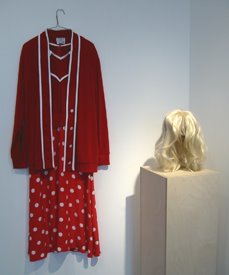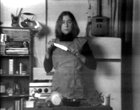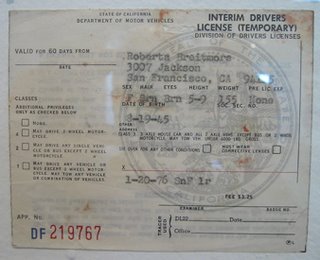 Another exhibition that closed on Saturday was “Elusive Materials” at New Langton Arts in San Francisco. This project was designed to show the work of artists “who have contributed to Langton’s history, and whose own practice involves an archival drive.”
Another exhibition that closed on Saturday was “Elusive Materials” at New Langton Arts in San Francisco. This project was designed to show the work of artists “who have contributed to Langton’s history, and whose own practice involves an archival drive.” It was meant to be a conceptual show, and it was. Happily, two participants were well-known women artists who demonstrated that conceptualism needn’t be dry. In signature works from the 1970s, they underlined a common theme of the Women’s Movement of that era, “the personal is the political.” Martha Rosler’s famous 7-minute B&W video from 1975, “Semiotics of the Kitchen,” shows herself demonstrating everyday kitchen implements, as if she’s on a TV cooking show. She performs with a deadpan face and voice but with angry gestures. The piece retains its bite. A brief excerpt can be streamed from the artist’s website. (Image above is from Electronic Arts Intermix.)
It was meant to be a conceptual show, and it was. Happily, two participants were well-known women artists who demonstrated that conceptualism needn’t be dry. In signature works from the 1970s, they underlined a common theme of the Women’s Movement of that era, “the personal is the political.” Martha Rosler’s famous 7-minute B&W video from 1975, “Semiotics of the Kitchen,” shows herself demonstrating everyday kitchen implements, as if she’s on a TV cooking show. She performs with a deadpan face and voice but with angry gestures. The piece retains its bite. A brief excerpt can be streamed from the artist’s website. (Image above is from Electronic Arts Intermix.) Stranger territory was explored by Lynn Hershman Leeson in a project that unfolded over most of the 1970s. The artist created the identity of a fictional person named Roberta Breitmore, using wigs, makeup, clothing, and altered behavior (photo at top). Roberta got a driver’s license (photo above), opened a checking account (photo below), qualified for credit cards, rented an apartment, placed classified ads to meet people, underwent a psychiatric evaluation, and so on. Eventually several other women (“multiples”) played Roberta as well. The presentation at New Langton is called “Roberta Breitmore’s Archive 1974-1978.” It includes the psychological evaluation (on letterhead), written in a dissociated style that was typical among psychiatrists but which seemed to echo the project’s creepy, fascinating investigation of identity.
Stranger territory was explored by Lynn Hershman Leeson in a project that unfolded over most of the 1970s. The artist created the identity of a fictional person named Roberta Breitmore, using wigs, makeup, clothing, and altered behavior (photo at top). Roberta got a driver’s license (photo above), opened a checking account (photo below), qualified for credit cards, rented an apartment, placed classified ads to meet people, underwent a psychiatric evaluation, and so on. Eventually several other women (“multiples”) played Roberta as well. The presentation at New Langton is called “Roberta Breitmore’s Archive 1974-1978.” It includes the psychological evaluation (on letterhead), written in a dissociated style that was typical among psychiatrists but which seemed to echo the project’s creepy, fascinating investigation of identity.
 Rosler and Hershman Leeson stole the show, but there were other works of some interest. James Tantum covered a huge wall with his obsessive hand-drawn personal calendars. On another wall, Allan Ruppersberg’s compact “Siste Viator” was installed. The Latin phrase, used on Roman tombstones, can be translated as “Pause, Wanderer” but is rendered as "Stop Traveler" for this piece. In appearance this work from 1993 is a small shelf of books in several languages, with dust covers that look old-fashioned but freshly printed (photo above left). The books are replicas made by the artist. Only an historical sleuth of considerable skill could discover the meaning of this work without a crib sheet. What you see are books that might have been read by young soldiers from four countries who fought the Battle of Arnhem in 1944. It is a memorial for the 8,000 who were killed. I think the piece is too clever by half, and why do the books look untouched? Still, once understood, the work leaves a trail in the mind.
Rosler and Hershman Leeson stole the show, but there were other works of some interest. James Tantum covered a huge wall with his obsessive hand-drawn personal calendars. On another wall, Allan Ruppersberg’s compact “Siste Viator” was installed. The Latin phrase, used on Roman tombstones, can be translated as “Pause, Wanderer” but is rendered as "Stop Traveler" for this piece. In appearance this work from 1993 is a small shelf of books in several languages, with dust covers that look old-fashioned but freshly printed (photo above left). The books are replicas made by the artist. Only an historical sleuth of considerable skill could discover the meaning of this work without a crib sheet. What you see are books that might have been read by young soldiers from four countries who fought the Battle of Arnhem in 1944. It is a memorial for the 8,000 who were killed. I think the piece is too clever by half, and why do the books look untouched? Still, once understood, the work leaves a trail in the mind.

Colter Jacobsen’s project was to re-create a version of his studio space. Lots of images and bits of text were arranged on one wall. One section (top photo immediately above) showed the frequent Jacobsen theme of pairing. The two packets of honey near the bottom make it clear that the artist is not talking about math. (Felix Gonzalez-Torres’s dual synchronized clocks are a favorite of this artist.) On the floor in front of the wall, a couple of boxes served as cubbyholes where personal materials are stored (bottom photo above). The temptation to root through these was strong, but I resisted.
 On the ground floor was an elaborate installation by Catalan artist Antonio Muntadas. It was his video work, “Between the Frames: The Forum.” Seven tiny video rooms were arranged side by side along an arc. The walls between the doorways suggested a colonnade around a public space. Multicolored lights bathed this structure, making it look (to me) like an opera set. The photo at right, taken from the New Langton website, shows a similar installation of the work at MIT.
On the ground floor was an elaborate installation by Catalan artist Antonio Muntadas. It was his video work, “Between the Frames: The Forum.” Seven tiny video rooms were arranged side by side along an arc. The walls between the doorways suggested a colonnade around a public space. Multicolored lights bathed this structure, making it look (to me) like an opera set. The photo at right, taken from the New Langton website, shows a similar installation of the work at MIT.In the video rooms, the screens presented an edited version of Muntadas’s 160 hours of interviews with art dealers, collectors, museum staff, critics, etc. The interviews were done in the 1980s and reflect the hype and greed of the 80s art market. There isn’t a section devoted to artists, although I understand the Epilogue includes a few artists talking. The total playing time for all the parts is 4 hours and 37 minutes.
The topic is historically interesting and highly relevant to the art market today, but the presentation undercuts individual voices by creating a Babel in which you can barely hear anything. The effect is intentional, but it’s frustrating. The piece looks inviting but then shuts you out. Transcripts of the videos were available for reference, but I wish they have been available to purchase.

No comments:
Post a Comment